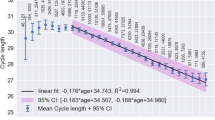Abstract
PSA levels have shown daily and seasonal variation, although data are conflicting regarding the season with higher PSA levels and the clinical relevance of this. We assessed the correlation of total PSA levels with meteorological data on a daily, weekly, monthly and seasonal basis. Data from 53 224 men aged 45–74 years, with an initial PSA <10.0 ng ml−1 were correlated with temperature (°C), duration of bright sunshine (hours) and rainfall (mm). There was seasonal variation in PSA levels, with median PSA being higher in spring compared with other seasons (1.18 vs 1.10 ng ml−1, P=0.004). Seasonal variation was not apparent when PSA levels were age-adjusted (P=0.112). Total PSA was not correlated with daily, weekly or monthly hours of sunshine, rainfall or mean temperature. In contrast, age-adjusted PSA varied with weekday, with higher PSA levels on Thursday and Friday compared with other days (1.16 vs 1.10 ng ml−1, respectively). On multivariate analysis, only age predicted for PSA levels >3.0 ng ml−1. In conclusion, PSA levels did show seasonal variation, although there was no direct correlation between PSA and any meteorological parameter. The degree of seasonal variation is small and the decision to proceed to prostate biopsy should be independent of season or weather parameters.
This is a preview of subscription content, access via your institution
Access options
Subscribe to this journal
Receive 4 print issues and online access
$259.00 per year
only $64.75 per issue
Buy this article
- Purchase on Springer Link
- Instant access to full article PDF
Prices may be subject to local taxes which are calculated during checkout


Similar content being viewed by others
References
Catalona WJ, Loeb S . The PSA era is not over for prostate cancer. Eur Urol 2005; 48: 541–545.
Soletormos G, Semjonow A, Sibley PE, Lamerz R, Petersen PH, Albrecht W et al. Biological variation of total prostate-specific antigen: a survey of published estimates and consequences for clinical practice. Clin Chem 2005; 51: 1342–1351.
Tchetgen MB, Oesterling JE . The effect of prostatitis, urinary retention, ejaculation, and ambulation on the serum prostate-specific antigen concentration. Urol Clin North Am 1997; 24: 283–291.
Herschman JD, Smith DS, Catalona WJ . Effect of ejaculation on serum total and free prostate-specific antigen concentrations. Urology 1997; 50: 239–243.
Chybowski FM, Bergstralh EJ, Oesterling JE . The effect of digital rectal examination on the serum prostate specific antigen concentration: results of a randomized study. J Urol 1992; 148: 83–86.
Pansadoro V, Emiliozzi P, Defidio L, Scarpone P, Sabatini G, Brisciani A et al. Prostate-specific antigen and prostatitis in men under fifty. Eur Urol 1996; 30: 24–27.
Luján Galán M, Pascual Mateo C, Rodríguez Garcia N, García Mediero JM, Pascual Durán T, Paez Borda A et al. Impact of the weather on the serum levels of prostatic specific antigen (PSA). Arch Esp Urol 2006; 59: 247–252.
Salama G, Noirot O, Bataille V, Malavaud S, Rebillard X, Villers A et al. Seasonality of serum prostate-specific antigen levels: a population-based study. Eur Urol 2007; 52: 708–714.
Connolly D . Long term follow-up of men with elevated prostate specific antigen levels: a population based study. MD thesis. Queen's University Belfast: Belfast, UK, 2007.
Connolly D, Black A, Murray LJ, Gavin A, Keane PF . Repeating an Abnormal Prostate-Specific Antigen (PSA) Level: How Relevant is a Decrease in PSA? Prostate Cancer Prostatic Dis 2009; 12: 47–51.
Connolly D, Black A, Gavin A, Keane PF, Murray LJ . Baseline prostate-specific antigen level and risk of prostate cancer and prostate-specific mortality: diagnosis is dependent on the intensity of investigation. Cancer Epidemiol Biomarkers Prev 2008; 17: 271–278.
Vieth R, Choo R, Deboer L, Danjoux C, Morton GC, Klotz L . Rise in prostate-specific antigen in men with untreated low-grade prostate cancer is slower during spring-summer. Am J Ther 2006; 13: 394–399.
Roenneberg T, Aschoff J . Annual rhythm of human reproduction: I Biology, sociology, or both? J Biol Rhythms 1990; 5: 195–216.
Roenneberg T, Aschoff J . Annual rhythm of human reproduction: II Environmental correlations. J Biol Rhythms 1990; 5: 217–239.
Cummings DR . Additional confirmation for the effect of environmental light intensity on the seasonality of human conceptions. J Biosoc Sci 2007; 39: 383–396.
Foster RG, Roenneberg T . Human responses to the geophysical daily, annual and lunar cycles. Curr Biol 2008; 18: R784–R794.
Carlsen E, Petersen JH, Andersson AM, Skakkebaek NE . Effects of ejaculatory frequency and season on variations in semen quality. Fertil Steril 2004; 82: 358–366.
Oremek GM, Seiffert UB . Physical activity releases prostate-specific antigen (PSA) from the prostate gland into blood and increases serum PSA concentrations. Clin Chem 1996; 42: 691–695.
Crawford ED III, Mackenzie SH, Safford HR, Capriola M . The effect of bicycle riding on serum prostate specific antigen levels. J Urol 1996; 156: 103–105.
Tucker A, Gilliland PJ . The effect of season and weather on physical activity: A systematic review. Public Health 2007; 121: 909–922.
Sumukadas D, Witham M, Struthers A, McMurdo M . Day length and weather conditions profoundly affect physical activity levels in older functionally impaired people. J Epidemiol Community Health 2009; 63: 305–309.
Acknowledgements
We thank James Vincent Smith from the UK Met Office for providing the meteorological data. This research was funded by the Northern Ireland Research and Development Office and by the Men Against Cancer charity. The Northern Ireland Cancer Registry is funded by the Public Health Agency, Northern Ireland. The funding bodies had no role in study design, data collection, data analysis, manuscript preparation or the decision to proceed to publication.
Author information
Authors and Affiliations
Corresponding author
Ethics declarations
Competing interests
The authors declare no conflict of interest.
Rights and permissions
About this article
Cite this article
Connolly, D., van Leeuwen, P., Bailie, J. et al. Daily, monthly and seasonal variation in PSA levels and the association with weather parameters. Prostate Cancer Prostatic Dis 14, 58–62 (2011). https://doi.org/10.1038/pcan.2010.37
Received:
Revised:
Accepted:
Published:
Issue Date:
DOI: https://doi.org/10.1038/pcan.2010.37
Keywords
This article is cited by
-
Relationship between prostate-specific antigen levels and ambient temperature
International Journal of Biometeorology (2014)



